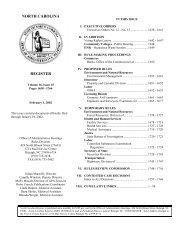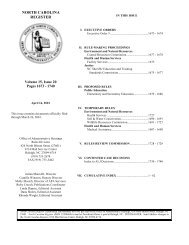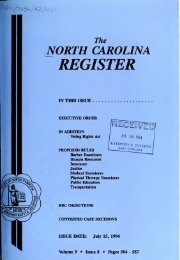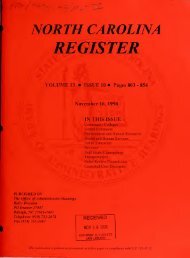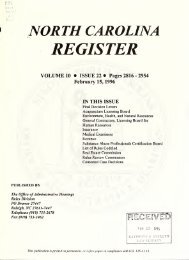NC Register Volume 21 Issue 09 - Office of Administrative Hearings
NC Register Volume 21 Issue 09 - Office of Administrative Hearings
NC Register Volume 21 Issue 09 - Office of Administrative Hearings
You also want an ePaper? Increase the reach of your titles
YUMPU automatically turns print PDFs into web optimized ePapers that Google loves.
CONTESTED CASE DECISIONS<br />
4. Petitioners bear the burden <strong>of</strong> pro<strong>of</strong> on the issues.<br />
5. Pursuant to the federal Clean Water Act, certain governmental entities are required to obtain NPDES Phase II<br />
stormwater permits to reduce and control stormwater pollution into public waters. 33 U.S.C. § 1342 (p)(2) (2006). In particular, with<br />
regard to the issues in this case, Mecklenburg County and the Towns <strong>of</strong> Mint Hill, Indian Trail, and Stallings are required to obtain<br />
NPDES Phase II stormwater permits for discharges <strong>of</strong> stormwater pollution from new development. 40 C.F.R. § 122.32 (2006).<br />
Contested <strong>Issue</strong> No. 1:<br />
6. Pursuant to 40 C.F.R. § 122.44(d) (2006) and N.C. Gen. Stat. § 143.<strong>21</strong>5.1(a)(6) (2006), Respondent was responsible<br />
for ensuring that the NPDES Phase II permits for Indian Trail, Stallings, and Mecklenburg County complied with all applicable state<br />
water quality requirements.<br />
7. North Carolina’s state water quality regulations recognize the protection <strong>of</strong> biological integrity as a state water<br />
quality standard and as a best usage <strong>of</strong> all freshwaters. 15A N.C. Admin. Code 02B.0<strong>21</strong>1(1) (2006).<br />
8. North Carolina regulations require that “[t]he water shall be suitable for aquatic life propagation and maintenance <strong>of</strong><br />
biological integrity, wildlife, secondary recreation, and agriculture. Sources <strong>of</strong> water pollution which preclude any <strong>of</strong> these uses on<br />
either a short-term or long-term basis shall be considered to be violating a water quality standard.” 15A N.C. Admin. Code<br />
02B.0<strong>21</strong>1(2) (2006).<br />
9. Biological integrity is “the ability <strong>of</strong> an aquatic ecosystem to support and maintain a balanced and indigenous<br />
community <strong>of</strong> organisms having species composition, diversity, population densities and functional organization similar to that <strong>of</strong><br />
reference conditions.” 15A N.C. Admin. Code 02B.0200(11) (2006). Respondent’s legal obligation to protect biological integrity<br />
necessarily includes the protection <strong>of</strong> the most sensitive species within a watershed. Id. Therefore, in the Goose Creek watershed,<br />
biological integrity encompasses the ability <strong>of</strong> the watershed to maintain the federally endangered Carolina heelsplitter population.<br />
10. Furthermore, North Carolina’s antidegradation policy requires that “existing uses” <strong>of</strong> all waters must be maintained.<br />
15A N.C. Admin. Code 02B.0201(b) (2006). North Carolina water quality standards recognize that an existing use <strong>of</strong> a water body<br />
includes providing habitat for endangered or threatened species. 15A N.C. Admin. Code 02B.0110 (2006). Since providing habitat for<br />
the Carolina heelsplitter is an existing use in the Goose Creek watershed, the NPDES Phase II stormwater permits must ensure that<br />
habitat for the Carolina heelsplitter is maintained and protected. 15A N.C. Admin. Code 02B.0201(b) (2006).<br />
11. Respondent violated the Clean Water Act and N.C. Gen. Stat. § 143.<strong>21</strong>5.1(a)(6) (2006) when it issued the permits without<br />
ensuring compliance with all applicable state water quality standards. This conclusion is supported by numerous Findings <strong>of</strong> Fact,<br />
which will not be recited again in detail here but which may be summarized as follows:<br />
a. The USFWS determined that certain stormwater mitigation measures were necessary to protect the federally<br />
endangered Carolina heelsplitter in Goose Creek. These measures include two-hundred-foot buffers on perennial streams and<br />
one-hundred-foot buffers on intermittent streams, a zero to six percent impervious surface threshold for triggering the need<br />
for structural stormwater controls, and water quality standards for the major constituents <strong>of</strong> concern.<br />
b. The USFWS provided its determinations to Respondent in the form <strong>of</strong> a draft Technical Support Document for the<br />
Goose Creek Site-Specific Management Plan well before the permits were issued.<br />
c. Respondent issued the three challenged NPDES Phase II stormwater permits with measures that fall well short <strong>of</strong> the<br />
USFWS’s determinations. The permits set the impervious surface threshold at twenty-four percent and only require a thirtyfoot<br />
setback <strong>of</strong> impervious surfaces from streams. According to the USFWS, the Carolina heelsplitter population in Goose<br />
Creek will be extirpated within two to five years if development is allowed as permitted by the three challenged NPDES<br />
Phase II stormwater permits.<br />
12. Respondent also violated the state antidegradation policy when it issued the permits without ensuring that the<br />
existing use <strong>of</strong> providing habitat for the federally endangered Carolina heelsplitter was adequately protected from stormwater<br />
discharges. Again, as detailed in the Findings <strong>of</strong> Fact, Respondent ignored the determinations made by the USFWS regarding<br />
stormwater measures that would be necessary to protect the Carolina heelsplitter population in Goose Creek.<br />
13. Because Respondent violated its own rules in issuing the permits without ensuring compliance with all state water<br />
quality standards and the state antidegradation policy, Respondent acted arbitrarily and capriciously in issuing the three challenged<br />
<strong>21</strong>:<strong>09</strong> NORTH CAROLINA REGISTER NOVEMBER 1, 2006<br />
874




